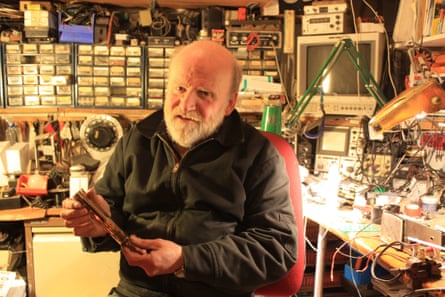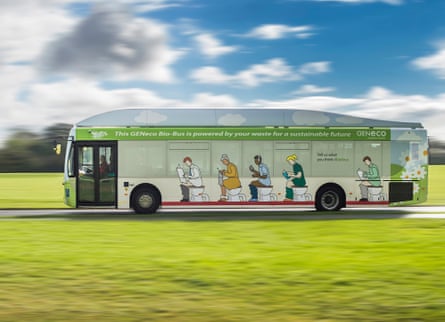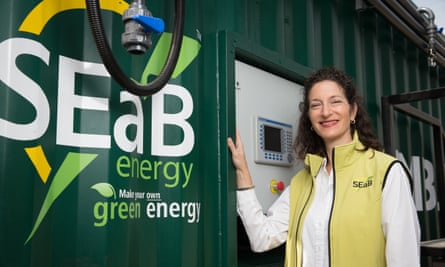A long winding road climbs into a gathering dusk, coming to an abrupt dead end in front of a house. Here, a solitary flickering flame casts out a warm glow, illuminating the nearby ridge line of the Malvern Hills.
Below the light sits a mysterious green contraption resembling a cross between a giant washing machine and a weather station. This is the UK’s first dog poo-powered street lamp, and it is generating light in more ways than one.
The idea seems simple enough: dog walkers deposit the product of a hearty walk into a hatch and turn a handle. The contents are then broken down by microorganisms in the anaerobic digester, producing methane to fuel the light, and fertiliser.

Brian Harper, who started work on the machine three years ago after becoming fed up of seeing plump little bags hanging in trees and on grass verges, reckons that 10 bags will power the light for two hours each evening.
“The gas light captures people’s imagination and shows them dog poo has a value,” says Harper, who developed the system with funding from the Malvern Hills Area of Outstanding Natural Beauty. “As a result, we get it [poo] off the ground, into a receptacle, and producing something useful.” The next step is to try to interest managers of urban parks in the technology.
Humans have used animal dung as fuel since the neolithic period, and have known how to get flammable gas from decaying organic matter since the 17th century. Small-scale anaerobic digesters are commonplace in many developing countries, while larger plants producing heat and electricity from animal manure and human sewage have long been used in the west.
Yet the energy in most excrement still goes to waste. Greater exploitation of this most plentiful resource has been held back by the availability of artificially cheap fossil fuel. But now Harper is at the vanguard of a new movement of innovators finding ingenious, sustainable ways of harnessing the power of excrement.
Local politicians in Waterloo in Ontario, Canada, are thinking along similar lines to tackle a different problem. Dog walkers who use three parks in the city are being asked to drop their pet’s poo into concrete storage units. These are periodically emptied by trucks that take it to a large central plant where it is broken down along with other forms of organic waste to produce methane and then electricity. The fertiliser byproduct is sold to farmers.
Analysis of the first five months of an 18-month trial suggests that at the current rate, the scheme would generate enough electricity to power 13 homes and remove 630kg of CO2 from the atmosphere. Modest returns perhaps – but not the main goals of the project.
“Collecting dog waste separately prevents it contaminating our recycling streams, allowing us to divert both away from our landfill sites,” says Jeff Silcox-Childs, Waterloo’s director of environment and parks.
In India, the use of small household biodigesters to get gas for fuel from cow manure is common. One social enterprise is deploying the technology on a larger scale as part of a major initiative to end open defecation in the country by 2019.
Sanitation and Health Rights in India (SHRI) turned to biodigestion as a way to keep public toilets clean – a major issue with existing communal facilities. At an initial cost of $30,000, SHRI builds blocks of 16 free-to-use toilets, half for men and half for women. The resulting sewage is broken down in a biodigester to produce methane, which powers a groundwater pump. The water is filtered, bottled and sold for half a rupee (half a pence) per litre, to pay for approximately half of the maintenance costs.

“We are using existing technologies in ways they haven’t been connected before to help people in India get the safe, well-maintained and hygienic toilets they deserve,” says SHRI’s cofounder Anoop Jain. The group opened its first community toilet block in 2014 and is currently building its seventh.
Back in the UK, the Bristol-based GENeco, a subsidiary of Wessex Water, ran its famous Bio-Bug trial in which a VW Beetle was converted to run on methane extracted from human waste. The use of biomethane from sewage plants to power cars is more widespread in other countries, such as Sweden.
In 2014 GENeco launched its Bio-Bus, the UK’s first bus powered by gas generated from sewage and food waste. Capable of running for 300km on a full tank, it produces significantly less carbon dioxide and air pollution than fossil fuel-powered equivalents. It ran in trials between Bath and Bristol Airport and then, naturally, on Bristol’s “Number 2” bus route.
GENeco also runs a facility that processes human sewage and food waste to generate enriched biomethane that is injected into the grid, providing fuel for some 5,000-6,000 homes. Severn Trent also opened an anaerobic digestion plant for sewage at Minworth near Birmingham in 2014.
“Our facility is no longer a traditional sewage treatment works but a factory, taking inputs including sewage and food waste and turning them into products including gas for cooking or transport and nitrogen- and phosphate-rich fertiliser,” says Mohammed Saddiq, managing director of GENeco. “People talk about the circular economy, but what we are doing is putting that vision into practice.”
While GENeco’s gas-to-grid operation is certainly greener than traditional facilities, there is another input that muddies the water. It, and others like it, receive subsidies under the government’s renewable heat incentive. Moreover some argue that large-scale operations involving transporting biomass to a central location are not necessarily the best of solutions.
This was the starting point for SEaB Energy, a Southampton-based company assembling modular, automated, odour-free anaerobic digesters in shipping containers. So far it has mainly sold units designed to process food waste, but it is currently assembling its first commercial Muckbuster units, due for installation in Japan and in Brazil in 2018.

Sandra Sassow, CEO and cofounder of SEaB, warns that some facilities that turn biomass, including excrement, into energy may not be as green as they appear, if, for example, they use fuel to transport waste a long way before it is turned into an energy source.
Right now, waste is collected, trucked, moved and processed, often ending up in landfill at worst or having some energy extracted from it at best, says Sassow.
“We want to disrupt that completely to incorporate decentralised, distributed, on-site appliances into farms and buildings around the world. A lot of things have been tried, but it’s a case of finding a technology that produces an energy benefit over the full life cycle, not just an apparent energy benefit.”

Comments (…)
Sign in or create your Guardian account to join the discussion